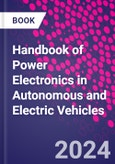Handbook of Power Electronics in Autonomous and Electric Vehicles provides advanced knowledge on autonomous systems, electric propulsion in electric vehicles, radars and sensors for autonomous systems, and relevant aspects of energy storage and battery charging. The work is designed to provide clear technical presentation with a focus on commercial viability. It supports any and all aspects of a project requiring specialist design, analysis, installation, commissioning and maintenance services. With this book in hand, engineers will be able to execute design, analysis and evaluation of assigned projects using sound engineering principles and commercial requirements, policies, and product and program requirements.
Please Note: This is an On Demand product, delivery may take up to 11 working days after payment has been received.
Table of Contents
1. Introduction to Autonomous VehiclesHamed Faghihian, James C. Holland and Arman Sargolzaei
2. Introduction to Autonomous Systems
Anurag Verma
3. Sensors for Autonomous Vehicles
Weiqiang Dong
4. Radars for Autonomous Systems
Onur Toker
5. Artificial Intelligent for Autonomous Vehicles
Mehdi Ahmadi Jirdehi Sr., Mohammad Shaterabadi, Hasan Mehrjerdi and Houshang Karimi
6. Cybersecurity for autonomous vehicles
Sreedhar Madichetty, Pathan Meeravali Khan and Abdelkader El Kamel
7. Security Challenges Facing Autonomous and Electric Vehicles
James C. Holland and Arman Sargolzaei
8. Intelligent energy management system for autonomous vehicles
Vahid Sohrabi Tabar
9. Hardware Security of Autonomous Vehicles
Syed Rafay Hasan and Faiq Khalid
10. Propulsion Drives and Control algorithms of Electrical Vehicles
Anton Rass�lkin
11. Power Electronics Controlled Electric Propulsion
Ersan Kabalci and Ayse Kocalmis Bilhan
12. Automotive Applications of Power Electronics
Anushree Ramanath
13. Solared-Powered Electric Vehicles
Mohammad Reza Maghami and Arthur Mutambara
14. Electrical energy storage in power electronics based systems
Anushree Ramanath
15. Battery charging technologies
Sreedhar Madichetty, Mohan Krishna Banda and Shanthi Kumar Nandavaram Banda
16. Autonomous and Electric Vehicles Charging Schemes without an Operator
S Kodeeswaran, Nandhini Gayathri, Sanjeevikumar Padmanaban and Kannabhiran A
17. Fuel-Cell Systems for Transportations
Mehmet Uzunoglu and Mohammad S. Alam
18. Monitoring Battery Status and facility conditions
Mohammad Reza Khalghani
19. Battery Characterization and Life-cycle
Morteza REZAEI LARIJANI, Shahin Hedayati Kia, Mohammad Reza Zolghadri and Ahmed EL Hajjaji
20. Impacts and Sustainability of Electric Vehicles
Anushree Ramanath








